Movie Retrospective: Dirty Harry
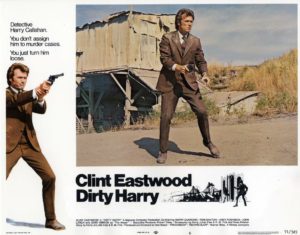
1971’s Dirty Harry remains one of the very best of the crime-thriller genre and showcases the persona of Clint Eastwood as the unorthodox police Inspector Harry Callahan, one of the actor’s most iconic and abiding roles. The San Francisco born actor is one of several reasons why this film works as well as it does and continues to have an impact to this very day. 41 years of age when the film went on theatrical release in December 1971, Eastwood appears in almost every scene and his considerable screen presence is utilised to excellent effect by director Don Siegel. The homicide detective is first seen during the opening credits and to the strains of composer Lalo Schifrin’s superb score. A young woman has been shot by a nameless killer in a rooftop pool somewhere in the Bay Area city. As the investigating officer, Callahan quickly discerns that the single gunshot may have come from a neighbouring building. There is no dialogue in this opening section of the film; Siegel simply conveys the central character’s intuition by means of visuals and reaction shots. A blackmail note close to the scene of the crime quickly tells us that we are in more than just a police procedural. The killer, who calls himself Scorpio, pulls no punches with his message to the city’s authorities – pay me the sum of $100,000 or else I will embark upon a killing spree. 100,000 dollars may not seem like a lot of money in this day and age, but bear in mind that this was the early seventies. Scorpio’s demand would, undoubtedly, involve a much larger figure today. But his deranged modus operandi would engender an equal degree of terror no matter what the period of time. This, for me, is one of the reasons why the film continues to have a particular resonance. The strategy of the serial killer is well thought out and seeks a financial remuneration. Scorpio will continue to kill unless he is paid. Psychotic yes, but also enterprising and not lacking in innovation.
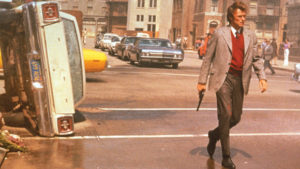
We get a sense of what the titular character is like from an early point. A meeting with the mayor of San Francisco (John Vernon, who would go on to play Fletcher in Eastwood’s 1976 The Outlaw Josey Wales) is followed by the foiling of a 211 at the bank. Harry is very much a police officer who believes in shooting first and asking questions later. When one of the would-be robbers attempts to reach for his gun, Callahan’s challenge to him is the basis for the film’s most memorable piece of dialogue – ‘I know what you’re thinking: ‘Did he fire six shots or only five?’ Well, to tell you the truth, in all this excitement, I kinda lost track myself. But being this is a .44 Magnum and will blow your head clean off, you’ve gotta ask yourself one question: ‘Do I feel lucky?’ Well, do you punk?’ A campaign of rooftop surveillance is initiated by the police as they seek to thwart Scorpio who has threatened to next kill an African-American or a Catholic priest. Detractors of the film have complained about racial slurs which frequent Dirty Harry and the central character makes one of these when he is introduced to his new partner who happens to be of Mexican extract. More pointedly, Harry reminds his boss Al Bressler (Harry Guardino) of the bloody fate that tends to befall his partners – ‘You know what happens to the guys I work with.’
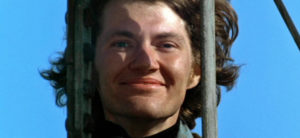
The New York actor Andy Robinson is perfectly cast as the relentless killer Scorpio who is intent on making some significant bucks from his considerable talent with a rifle. Director Siegel apparently told Robinson that he chose him for the role because he wanted someone ‘with a face like a choirboy.’ Such a disconcerting motif is made good upon in the following scene in which Scorpio stalks his next victim near the Saints Peter and Paul Church in the North Beach area of San Francisco. Given the location, the audience is lured into the assumption that Scorpio intends to kill a priest; but then he switches his attention to an African-American in a nearby public park. A police helicopter impedes Scorpio’s plan on this occasion, but the impression the scene leaves us with is that of a beaming killer who is more methodical than unbalanced. Robinson’s overall performance in the film was so effective that he reportedly received death threats in the wake of the film’s release. That’s suffering for one’s art indeed if one considers that the actor was a pacifist in real life.
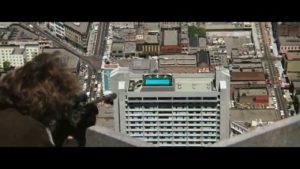
The use of locations in and around the City by the Bay is something worth commenting upon as well and is on something of a par with Hitchcock’s Vertigo which had been shot there over a decade before. Many landmark buildings and structures are utlised to good effect including the Golden Gate Bridge and the City Hall. But what is also striking about the visual style of Dirty Harry is the amount of night-time scenes which pervade the film. The more sleazy side of the urban milieu is picked out with exteriors of Big Al’s Strip Club at 556 Broadway and the Roaring 20’s Strip Club at 552 Broadway. When Harry and his new partner Chico Gonzalez (Reni Santoni) pursue a man who resembles Scorpio, we are left in little doubt as to the underbelly and seedy side of the inner city – ‘I had another thought about why they call you Dirty Harry’ Chico informs Callahan after the latter is mistaken for a Peeping Tom. One of the film’s more amusing scenes occurs when Harry attempts to talk down a suicide jumper using highly unconventional methods. The more dramatic tone is quickly returned to when Scorpio claims another victim – a young black boy shot in the face. In a renewed attempt to stop Scorpio for once and for all, the police determine upon a ploy whereby the killer will be enticed to return to the Saints Peter and Paul Church in North Beach. Callahan and his superiors surmise that the ego of the killer will inform his motivation, added to the fact that he may ‘owe himself a padre’ in Harry’s words. The ensuing stakeout does not go according to plan involving as it does an exchange of gunfire and the death of a police officer attired in the garb of a priest. A furious Scorpio then ups the ante when he abducts a 14-year-old girl (Ann Mary Deacon) and increases his financial demand to a sum of $200,000. The ultimatum issued to the authorities is simple, but evil-minded to the core: pay the killer the ransom or else the young girl – who has been buried alive – will run out of air by three the next morning.
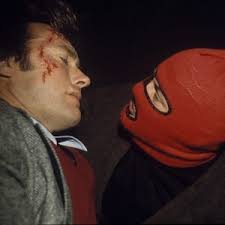
Harry accepts the job as the bag man for the delivery of the money and the sequence in which Scorpio makes him run all over town with a yellow suitcase is one of the most memorable in Dirty Harry. This section of the film culminates at the cross in Mount Davidson Park where a balaclava-donning Scorpio reneges on his side of the deal and declares his intention to let the girl die and also kill Harry in the process. Unknown to him – and to Callahan’s superiors – Chico has been in pursuit and, again, an exchange of fire follows. Gonzalez is shot, but the injured Harry manages to stab Scorpio in the leg. The killer flees the scene without the ransom money and receives treatment in an emergency room. Callahan is reprimanded by his boss Bressler, who was unaware of Gonzalez’s involvement, but a break comes their way when Harry receives a call from a doctor who has treated the wounded Scorpio. Accompanied by Frank DiGiorgio (John Mitchum), Callahan learns that the killer is residing in a nearby football stadium (Kezar Stadium) where he sometimes works selling programs. One of my own personal favourite scenes in the film takes place as Harry chases the injured Scorpio onto the football pitch and DiGiorgio turns on the stadium floodlights. Hell-bent upon learning the location of the abducted teenager, Callahan shoots Scorpio in the leg and then tortures him in an effort to get the information he requires – ‘Where’s the girl!’ The camera pulls back from this position and into a wide shot of the stadium on what appears to be a typically foggy San Francisco night. The issue of police brutality and the methods employed by the central character in his pursuit of justice are themes which have been discussed long and hard in relation to Dirty Harry. At this very moment, the director seems to make a conscious decision to leave the manner and extent of Harry’s unorthodox techniques to the imagination of the viewer. There’s little doubt that Callahan’s approach is vicious, and practically unlawful, but just how far is he willing to go we ask ourselves. From a purely technical point of view, this glorious shot is provided courtesy of cinematographer Bruce Surtees who, incidentally, worked on Eastwood’s two other films of this same year – The Beguiled and Play Misty For Me.
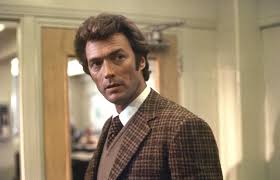
In spite of Harry’s best efforts, Ann Mary Deacon is found dead and the homicide inspector is further riled when he learns that Scorpio will walk free on account of his rights having been violated by the overly forcible nature of his arrest – ‘Well, I’m all broken up about that man’s rights!’ The bureaucracy which permeates the institutions of power and the excessively complicated administrative procedures of officialdom are issues which the film’s script (by Harry Julian Fink, R.M. Fink, Dean Riesner and an uncredited John Milius) is not shy of emphasising. Critics of the film would counter such arguments by drawing attention to the violent means used by the central character which involve cruelty almost on a par with the criminal he is seeking to apprehend. It’s interesting to note how the first Dirty Harry sequel (1973’s Magnum Force) would subsequently place Harry on the side of the authorities opposed to the death squad of young police officers who have decided to take the law into their own hands. Making good on his promise to track Scorpio after his release from hospital, Harry is seen observing the killer at a children’s playground and, later on, at a strip bar. But Scorpio proves himself to be a worthy and committed adversary and one step ahead in this cat-and-mouse game; deciding upon an extreme course of action, he has himself beaten to a pulp in the film’s most graphic scene. Claiming police brutality on television, the killer is specific regarding one particular name – ‘His name is Callahan…he’s a big cop…works homicide.’ Quizzed once again about his method of working, Callahan admits to his tailing of Scorpio on his own personal time, but is adamant that he did not beat the killer up – ‘Anybody can tell I didn’t do that to him…cause he looks too damned good, that’s how!’
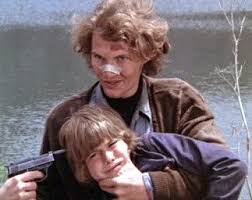
Some of Harry’s personal backstory comes to light in the scene in which he visits Chico in hospital and, later, tells Gonzalez’s wife of how his own wife was killed by a drunken driver. One of the most notable features of Dirty Harry is the sheer tightness of the production and the narrative generally and one can’t help but remark upon how such quieter moments in the film are not dwelled upon for very long. A director who was well used to working within the confines of limited budgets and constrained productions, Don Siegel believed fervently in telling his story with few moments of digression or meditation. His style had a lasting influence on Eastwood as a director himself who is renowned for his one-good-take-will-suffice approach. Eastwood’s 1992 Oscar-winning western Unforgiven is fittingly dedicated to Siegel and Sergio Leone. The narrative thread of Dirty Harry is swiftly resumed when Scorpio takes control of a school bus of seven young children and their driver. Demanding once again that the city of San Francisco pay him $200,000 dollars, Scorpio also requests safe passage on a jet from Santa Rosa Airport. A visibly disgruntled Harry refuses the job of delivery man on this occasion, but determines on his own course of action – ‘When are you people going to stop messing around with this guy?’ As the school bus makes its way towards the airport, Harry is sighted in the distance standing on a railway bridge awaiting its approach. Jumping on as it passes, he manages to stay atop in spite of Scorpio’s best efforts. The bus comes to a grinding halt near a quarry and Harry pursues the killer to the bank of a river. Scorpio takes a young boy hostage, but is shot by Harry as he feigns to drop his guard. A memorable face-off takes place as Harry effectively repeats the challenge he had given the bank robber following the 211 much earlier in the film – ‘I know what you’re thinking: ‘Did he fire six shots or only five?’ But his voice and attitude is infused with a definite animosity now; he wants Scorpio to reach for that gun; he does not want the killer to fall into the arms of the justice system with its plethora of inconsistencies and shortcomings. Scorpio duly obliges by going for his weapon and is dispatched into the river. His lifeless body floats downstream and the last action of the film involves Harry tossing his inspector’s badge into the water. This symbolic gesture has often been compared to the final act in 1952’s High Noon in which Gary Cooper’s Will Kane throws his marshal’s star to the ground in front of the townspeople.
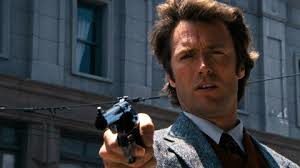
The commercial success of Dirty Harry led to four sequels in which Eastwood revisited the character. In order of chronology they are Magnum Force (1973), The Enforcer (1976), Sudden Impact (1983) and The Dead Pool (1988). Of the Harry sequels, I would personally have to rate the aforementioned Magnum Force (which was written by John Milius and Michael Cimino) the best and probably The Dead Pool (directed by Buddy Van Horn) the weakest. 1976’s The Enforcer – in which Harry acquires a female partner in the guise of Tyne Daly – is not half bad and 1983’s Sudden Impact (the only Harry film directed by Eastwood himself) has its moments – ‘Go ahead, make my day.’ The 1971 original is by far the best of the series and stands up to repeated viewings. As I mentioned previously, it’s one of Eastwood’s most seminal roles and benefits also from the performance of Andy Robinson as Scorpio. It’s hard to imagine anyone else in the central part but Eastwood and Dirty Harry represented the fourth of his five collaborations with Don Siegel. The Chicago-born director, who passed away in 1991, is acknowledged by Eastwood as having had a significant impact on his work behind the camera. Eastwood’s own directorial debut Play Misty For Me (released just a month earlier in 1971) features Siegel in a cameo appearance playing a bartender. 1971 also saw the release of one of their other big screen collaborations, namely The Beguiled. The reputation of that particular film has grown over the years, just as has the stature of Dirty Harry. One of the best cop films of all time you ask. Most assuredly say I.
Charles Davis, aka “Scorpio” was too much to handle for any cop, almost too bad case eaven for Harry Callahan.
Taking down few bank robbers was just any days job for Harry wich he could do while eating his lunch hot dog. But Scorpio was totally something else. Through and through maniac psycopath, tactical and intelligent.
For me Scorpio is a mystery. Who was he, what made him tick? That was never mentioned in the movie.
Ironicly, in the first sequale film of Dirty Harry, Magnum Force, one of the villains is also called Davis, but this time he carries a badge. Otherwise, this 1973 model Davis is a psycho killer who just goes after high profile criminals, and anyone who gets on his way.
Harry Callahan knew how to handle the toughest and the meanest bad guys, he knew how to survive. He never actually wanted a violent encounters with villains, but those situations often just reached him.